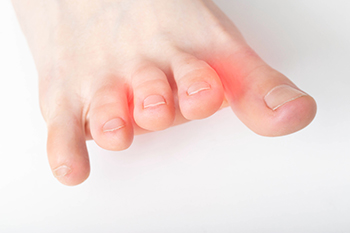 Toe pain can be an uncomfortable sensation. It may affect the ability to walk and can cause difficulty in completing daily activities. The medical term for a burning feeling in the toes is referred to as paresthesia. Toe pain can be chronic or sporadic, and this may be contingent of the origin of pain or why your toe is hurting. It can be caused by several reasons including the development of a bunion, or if there are existing calluses, corns, or sores on the toes. Additionally, hammertoe may be a common source of toe pain and this may be the result of genetic factors, or possibly from wearing shoes that do not have adequate room for the toes to move freely in. If you have toe pain it is strongly suggested that you consult with a podiatrist who can effectively diagnose your toe pain and help you with proper treatment techniques.
Toe pain can be an uncomfortable sensation. It may affect the ability to walk and can cause difficulty in completing daily activities. The medical term for a burning feeling in the toes is referred to as paresthesia. Toe pain can be chronic or sporadic, and this may be contingent of the origin of pain or why your toe is hurting. It can be caused by several reasons including the development of a bunion, or if there are existing calluses, corns, or sores on the toes. Additionally, hammertoe may be a common source of toe pain and this may be the result of genetic factors, or possibly from wearing shoes that do not have adequate room for the toes to move freely in. If you have toe pain it is strongly suggested that you consult with a podiatrist who can effectively diagnose your toe pain and help you with proper treatment techniques.
Foot Pain
Foot pain can be extremely painful and debilitating. If you have a foot pain, consult with one of our podiatrists from Biebel & DeCotiis Podiatry Associates. Our doctors will assess your condition and provide you with quality foot and ankle treatment.
Causes
Foot pain is a very broad condition that could be caused by one or more ailments. The most common include:
- Bunions
- Hammertoes
- Plantar Fasciitis
- Bone Spurs
- Corns
- Tarsal Tunnel Syndrome
- Ingrown Toenails
- Arthritis (such as Gout, Rheumatoid, and Osteoarthritis)
- Flat Feet
- Injury (from stress fractures, broken toe, foot, ankle, Achilles tendon ruptures, and sprains)
- And more
Diagnosis
To figure out the cause of foot pain, podiatrists utilize several different methods. This can range from simple visual inspections and sensation tests to X-rays and MRI scans. Prior medical history, family medical history, and any recent physical traumatic events will all be taken into consideration for a proper diagnosis.
Treatment
Treatment depends upon the cause of the foot pain. Whether it is resting, staying off the foot, or having surgery; podiatrists have a number of treatment options available for foot pain.
If you have any questions, please feel free to contact one of our offices located in Holmdel and Middletown, NJ . We offer the newest diagnostic and treatment technologies for all your foot care needs.




